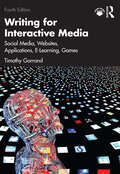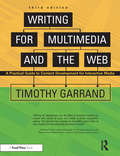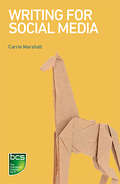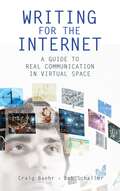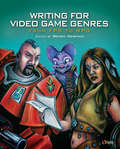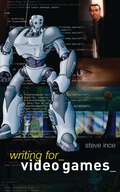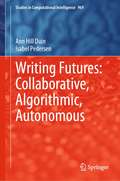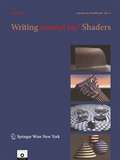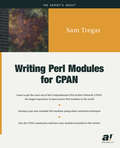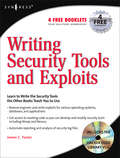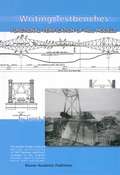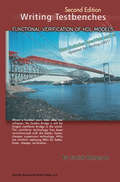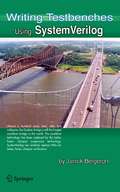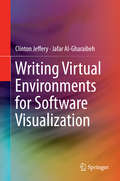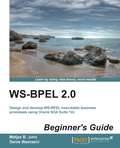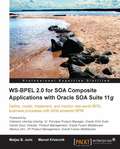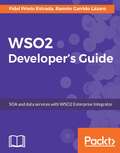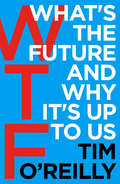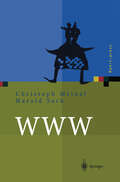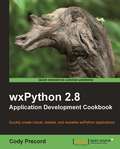- Table View
- List View
Writing for Interactive Media: Social Media, Websites, Applications, e-Learning, Games
by Timothy GarrandThis thoroughly revised fourth edition teaches students and professionals how to create interactive content for all types of new media and become successful writers or designers in a variety of fields.This comprehensive guide is grounded in the core principles and skills of interactive media writing, in which writers create text and structure content to guide users through interactive products such as websites or software. The book examines case studies on interactive formats including complex informational websites, computer games, e-learning courses, training programs, and immersive exhibits. These case studies assess real-world products and documentation used by professional writers such as scripts, outlines, screenshots, and flowcharts. The book also provides practical advice on how to use interactive media writing skills to advance careers in the social media, technical, instructional communication, and creative media fields. This edition includes new chapters on UX Writing and Content Design, Social Media Writing, and Writing for Mobile.Writing for Interactive Media prepares students for the writing challenges of today’s technology and media. It can be used as a core textbook for courses in UX Writing, Writing for Digital Media, and Technical and Professional Communication and is a valuable resource for writing professionals at all levels.Supplemental resources include a sample syllabus, class assignments, student exercises, scripts, outlines, flowcharts, and other interactive writing samples. They are available online at www.routledge.com/9781032554242
Writing for Interactive Media: Social Media, Websites, Applications, e-Learning, Games
by Timothy GarrandThis thoroughly revised fourth edition teaches students and professionals how to create interactive content for all types of new media and become successful writers or designers in a variety of fields.This comprehensive guide is grounded in the core principles and skills of interactive media writing, in which writers create text and structure content to guide users through interactive products such as websites or software. The book examines case studies on interactive formats including complex informational websites, computer games, e-learning courses, training programs, and immersive exhibits. These case studies assess real-world products and documentation used by professional writers such as scripts, outlines, screenshots, and flowcharts. The book also provides practical advice on how to use interactive media writing skills to advance careers in the social media, technical, instructional communication, and creative media fields. This edition includes new chapters on UX Writing and Content Design, Social Media Writing, and Writing for Mobile.Writing for Interactive Media prepares students for the writing challenges of today’s technology and media. It can be used as a core textbook for courses in UX Writing, Writing for Digital Media, and Technical and Professional Communication and is a valuable resource for writing professionals at all levels.Supplemental resources include a sample syllabus, class assignments, student exercises, scripts, outlines, flowcharts, and other interactive writing samples. They are available online at www.routledge.com/9781032554242
Writing for Multimedia and the Web: A Practical Guide to Content Development for Interactive Media
by Timothy GarrandLearning how to write for just one type of interactive media, such as web sites or games, is not enough! To be truly successful as an interactive writer or designer, you need to understand how to create content for all types of new media.Writing for Multimedia and the Web is the most comprehensive guide available for interactive writing. It covers web sites, computer games, e-learning courses, training programs, immersive exhibits, and much more. Earlier editions have garnered rave reviews as a writing handbook for multimedia and web professionals, as well as a classroom text for interactive writing and design.New Sections and Completely Updated Chapters:*Writing a corporate web site: T. Rowe Price*Creating blogs and podcasts*Web writing tips from usability experts*Optimizing text for web search engines*Defining the user with use cases and user scenarios*Dealing with web editors*Software for organizing and writing interactive media content*Script formats for all types of multimedia and web projects*Writing careers
Writing for Multimedia and the Web: A Practical Guide to Content Development for Interactive Media
by Timothy GarrandLearning how to write for just one type of interactive media, such as web sites or games, is not enough! To be truly successful as an interactive writer or designer, you need to understand how to create content for all types of new media.Writing for Multimedia and the Web is the most comprehensive guide available for interactive writing. It covers web sites, computer games, e-learning courses, training programs, immersive exhibits, and much more. Earlier editions have garnered rave reviews as a writing handbook for multimedia and web professionals, as well as a classroom text for interactive writing and design.New Sections and Completely Updated Chapters:*Writing a corporate web site: T. Rowe Price*Creating blogs and podcasts*Web writing tips from usability experts*Optimizing text for web search engines*Defining the user with use cases and user scenarios*Dealing with web editors*Software for organizing and writing interactive media content*Script formats for all types of multimedia and web projects*Writing careers
Writing for Social Media
by Carrie MarshallEngaging with customers through social media is essential for businesses in this day and age. Writing for social media can be difficult to get right and even big brands can get it very wrong. This book walks you through how to deliver maximum benefit for your business through your social media writing. Topics include how to develop an online persona, how to tailor your messages across different social media platforms, how to appeal to your audience, and how to use social media tools.
Writing for Social Media: Business And Technical Writing Series
by Carrie MarshallEngaging with customers through social media is essential for businesses in this day and age. Writing for social media can be difficult to get right and even big brands can get it very wrong. This book walks you through how to deliver maximum benefit for your business through your social media writing. Topics include how to develop an online persona, how to tailor your messages across different social media platforms, how to appeal to your audience, and how to use social media tools.
Writing for the Internet: A Guide to Real Communication in Virtual Space (Non-ser.)
by Craig Baehr Robert C. Jr.This book is a landmark guide full of practical examples and sound advice for communicating online concisely and effectively.Intended for students—and everyone else who writes for online media—Writing for the Internet: A Guide to Real Communication in Virtual Space is a landmark collection of grounded and practical applications about writing effectively and concisely. It covers just about everything one needs to know about a broad array of topics including online publishing, new media news writing, blogging, micro-blogging, Internet writing technologies, and social media/ownership. At the same time, it addresses theories, methods, and practices used by Internet writers and online journalists from a wide range of backgrounds.The book introduces students who will be writing online—and this includes all disciplines of every possible major—to the basic tenets of good online writing habits and principles. It will help bloggers hone their thoughts and express them in writing that works in real-time media. And it will help those who wish to take advantage of the extraordinary profit-making potential the Internet represents.
Writing for Video Game Genres: From FPS to RPG
by Wendy DespainThis book, written and edited by members of the International Game Developers Association (IGDA) Game Writing Special Interest Group, follows the acclaimed Professional Techniques for Video Game Writing to deliver practical advice from seasoned veterans on the special challenges of writing for first-person shooter games (FPS), role-playing games (R
Writing for Video Games (Professional Media Practice)
by Steve InceVideo games is a lucrative new market for scriptwriters but writing for video games is complex and very different to traditional media (tv or film). This practical guide shows how you can adapt your writing skills to this exciting medium. Written by an award-winning games writer, the book gives you a realistic picture of how games companies work, how the writer fits into the development process, and the skills required: from storytelling, to developing interactive narrative, characters and viewpoints, dialogue comedy and professional practice. Illustrated with examples from games and quotes from developers, writers and agents, this is a cutting edge professional writing guide at a very accessible price.
Writing Futures: Collaborative, Algorithmic, Autonomous (Studies in Computational Intelligence #969)
by Ann Hill Duin Isabel PedersenThis book is useful to understand and write alongside non-human agents, examine the impact of algorithms and AI on writing, and accommodate relationships with autonomous agents. This ground-breaking future-driven framework prepares scholars and practitioners to investigate and plan for the social, digital literacy, and civic implications arising from emerging technologies. This book prepares researchers, students, practitioners, and citizens to work with AI writers, virtual humans, and social robots. This book explores prompts to envision how fields and professions will change. The book’s unique integration with Fabric of Digital Life, a database and structured content repository for conducting social and cultural analysis of emerging technologies, provides concrete examples throughout. Readers gain imperative direction for collaborative, algorithmic, and autonomous writing futures.
Writing In-House Medical Device Software in Compliance with EU, UK, and US Regulations
by Philip S. Cosgriff Matthew J. MemmottThis book is a comprehensive guide to producing medical software for routine clinical use. It is a practical guidebook for medical professionals developing software to ensure compliance with medical device regulations for software products intended to be sold commercially, shared with healthcare colleagues in other hospitals, or simply used in-house.It compares requirements and latest regulations in different global territories, including the most recent EU regulations as well as UK and US regulations.This book is a valuable resource for practising clinical scientists producing medical software in-house, in addition to other medical staff writing small apps for clinical use, clinical scientist trainees, and software engineers considering a move into healthcare. The academic level is post-graduate, as readers will require a basic knowledge of software engineering principles and practice.Key Features: Up to date with the latest regulations in the UK, the EU, and the US Useful for those producing medical software for routine clinical use Contains best practice
Writing In-House Medical Device Software in Compliance with EU, UK, and US Regulations
by Philip S. Cosgriff Matthew J. MemmottThis book is a comprehensive guide to producing medical software for routine clinical use. It is a practical guidebook for medical professionals developing software to ensure compliance with medical device regulations for software products intended to be sold commercially, shared with healthcare colleagues in other hospitals, or simply used in-house.It compares requirements and latest regulations in different global territories, including the most recent EU regulations as well as UK and US regulations.This book is a valuable resource for practising clinical scientists producing medical software in-house, in addition to other medical staff writing small apps for clinical use, clinical scientist trainees, and software engineers considering a move into healthcare. The academic level is post-graduate, as readers will require a basic knowledge of software engineering principles and practice.Key Features: Up to date with the latest regulations in the UK, the EU, and the US Useful for those producing medical software for routine clinical use Contains best practice
Writing mental ray® Shaders: A Perceptual Introduction (mental ray® Handbooks #3)
by Andy KopraAn increasing number of artists and programmers in visual effects and broadcast production now use mental ray, a high performance rendering engine for generating photorealistic images. This book details the aesthetics of rendering with mental ray. It describes the varieties of shader programming from the point of view of increasing perceptual complexity: from color to the output of the final image. It includes many example shaders, including the simplest shader possible in each category that can serve as a starting point for further customization.
Writing Perl Modules for CPAN
by Sam TregarThe author Sam Tregar tells programmers how best to use and contribute modules to the Open Source repository known as CPAN (Comprehensive Perl Archive Network).
Writing Security Tools and Exploits
by James C FosterWriting Security Tools and Exploits will be the foremost authority on vulnerability and security code and will serve as the premier educational reference for security professionals and software developers. The book will have over 600 pages of dedicated exploit, vulnerability, and tool code with corresponding instruction. Unlike other security and programming books that dedicate hundreds of pages to architecture and theory based flaws and exploits, this book will dive right into deep code analysis. Previously undisclosed security research in combination with superior programming techniques will be included in both the Local and Remote Code sections of the book. The book will be accompanied with a companion Web site containing both commented and uncommented versions of the source code examples presented throughout the book. In addition to the book source code, the CD will also contain a copy of the author-developed Hacker Code Library v1.0. The Hacker Code Library will include multiple attack classes and functions that can be utilized to quickly create security programs and scripts. These classes and functions will simplify exploit and vulnerability tool development to an extent never before possible with publicly available software.* Provides readers with working code to develop and modify the most common security tools including Nmap and Nessus* Learn to reverse engineer and write exploits for various operating systems, databases, and applications* Automate reporting and analysis of security log files
Writing Testbenches: Functional Verification of HDL Models
by Janick BergeronCHAPTER 6 Architecting Testbenches 221 Reusable Verification Components 221 Procedural Interface 225 Development Process 226 Verilog Implementation 227 Packaging Bus-Functional Models 228 Utility Packages 231 VHDL Implementation 237 Packaging Bus-Functional Procedures 238 240 Creating a Test Harness 243 Abstracting the Client/Server Protocol Managing Control Signals 246 Multiple Server Instances 247 Utility Packages 249 Autonomous Generation and Monitoring 250 Autonomous Stimulus 250 Random Stimulus 253 Injecting Errors 255 Autonomous Monitoring 255 258 Autonomous Error Detection Input and Output Paths 258 Programmable Testbenches 259 Configuration Files 260 Concurrent Simulations 261 Compile-Time Configuration 262 Verifying Configurable Designs 263 Configurable Testbenches 265 Top Level Generics and Parameters 266 Summary 268 CHAPTER 7 Simulation Management 269 Behavioral Models 269 Behavioral versus Synthesizable Models 270 Example of Behavioral Modeling 271 Characteristics of a Behavioral Model 273 x Writing Testbenches: Functional Verification of HDL Models Modeling Reset 276 Writing Good Behavioral Models 281 Behavioral Models Are Faster 285 The Cost of Behavioral Models 286 The Benefits of Behavioral Models 286 Demonstrating Equivalence 289 Pass or Fail? 289 Managing Simulations 292 294 Configuration Management Verilog Configuration Management 295 VHDL Configuration Management 301 SDF Back-Annotation 305 Output File Management 309 Regression 312 Running Regressions 313 Regression Management 314 Summary 316 APPENDIX A Coding Guidelines 317 Directory Structure 318 VHDL Specific 320 Verilog Specific 320 General Coding Guidelines 321 Comments 321 Layout 323 Syntax 326 Debugging 329 Naming Guidelines 329 Capitalization 330 Identifiers 332 Constants 334 334 HDL Specific Filenames 336 HDL Coding Guidelines 336 337 Structure 337 Layout
Writing Testbenches: Functional Verification of HDL Models
by Janick Bergeronmental improvements during the same period. What is clearly needed in verification techniques and technology is the equivalent of a synthesis productivity breakthrough. In the second edition of Writing Testbenches, Bergeron raises the verification level of abstraction by introducing coverage-driven constrained-random transaction-level self-checking testbenches all made possible through the introduction of hardware verification languages (HVLs), such as e from Verisity and OpenVera from Synopsys. The state-of-art methodologies described in Writing Test benches will contribute greatly to the much-needed equivalent of a synthesis breakthrough in verification productivity. I not only highly recommend this book, but also I think it should be required reading by anyone involved in design and verification of today's ASIC, SoCs and systems. Harry Foster Chief Architect Verplex Systems, Inc. xviii Writing Testbenches: Functional Verification of HDL Models PREFACE If you survey hardware design groups, you will learn that between 60% and 80% of their effort is now dedicated to verification.
Writing Testbenches using SystemVerilog
by Janick BergeronVerification is too often approached in an ad hoc fashion. Visually inspecting simulation results is no longer feasible and the directed test-case methodology is reaching its limit. Moore's Law demands a productivity revolution in functional verification methodology. Writing Testbenches Using SystemVerilog offers a clear blueprint of a verification process that aims for first-time success using the SystemVerilog language. From simulators to source management tools, from specification to functional coverage, from I's and O's to high-level abstractions, from interfaces to bus-functional models, from transactions to self-checking testbenches, from directed testcases to constrained random generators, from behavioral models to regression suites, this book covers it all. Writing Testbenches Using SystemVerilog presents many of the functional verification features that were added to the Verilog language as part of SystemVerilog. Interfaces, virtual modports, classes, program blocks, clocking blocks and others SystemVerilog features are introduced within a coherent verification methodology and usage model. Writing Testbenches Using SystemVerilog introduces the reader to all elements of a modern, scalable verification methodology. It is an introduction and prelude to the verification methodology detailed in the Verification Methodology Manual for SystemVerilog. It is a SystemVerilog version of the author's bestselling book Writing Testbenches: Functional Verification of HDL Models.
Writing Virtual Environments for Software Visualization
by Clinton Jeffery Jafar Al-GharaibehWriting Virtual Environments for Software Visualization book describes the software for a networked, 3D multi-user virtual environment that allows users to create and share remotely visualizations of program behavior. Collaborative virtual environments such as World of Warcraft or Second Life are a popular way to share interactive internet experiences, but they are complex and difficult to create. Software visualization is an area that may enable important advances in our ability to understand and reduce the costs of maintaining software. Applying the former technology to this problem area will be valuable to distributed and multi-institutional software development and educational users. The author covers the major features of collaborative virtual environments and how to program them in a very high level language. The book also examines the application of popular game-like software technologies.
WS-BPEL 2.0 Beginner's Guide
by Matjaz B. Juric Denis WeerasiriIf you are a software architect, a designer, a software developer, an SOA and BPM architect, a project manager, or a business process analyst who is responsible for the design and development of business processes, composite applications, and BPM/SOA solutions, then this book is for you. You should have a clear grasp of general SOA concepts including business processes and web services, but no prior knowledge of the BPEL language is required.
WS-BPEL 2.0 for SOA Composite Applications with Oracle SOA Suite 11g
by Matjaz B. Juric Marcel KrizevnikThis book is a comprehensive guide that shows developers how to design and develop business processes in BPEL efficiently. Throughout the book, the authors discuss important concepts and show real-world examples covering Oracle SOA Suite 11g and related products. This book is aimed at SOA architects and developers involved in the design, implementation, and integration of composite applications and end-to-end business processes. The book provides comprehensive coverage of WS-BPEL 2.0 for implementing business processes and developing SCA composite application, dealing with the issues of composition, orchestration, transactions, coordination, and security. This book uses Oracle SOA Suite 11g and related Oracle products. To follow this book you need to have basic knowledge of XML, web services, and Java EE.
WSO2 Developer's Guide: SOA and data services with WSO2 Enterprise Integrator
by Fidel Prieto Estrada Ramon Garrido LazaroWSO2 Made Simple – dive deep into the core concepts of WSO2 to overcome the challenges faced while using the Enterprise Integrator About This Book • Design, create, and publish services in the WSO2 technology • Integrate the WSO2 Enterprise Integrator with other components and servers • Log and test deployed services Who This Book Is For If you are a Java solutions architect or developer and are keen to understand how to build enterprise applications with WSO2, this book is for you. No prior knowledge of WSO2 is expected. What You Will Learn • Configure WSO2 Enterprise Integrator server in a production environment • Create SOAP Proxies and REST APIs • Interact with WSO2 Message Broker • Write services using the new language: Ballerina • Schedule automatic tasks for the services you create • Manage log messages depending on the log level of the system • Integrate with social networks such as Twitter, Facebook, Instagram, and Yammer • Test SOAP Services using the Tryit feature and SoapUI tool • Work with Quality of Services In Detail WSO2 Enterprise Integrator brings together the most powerful servers provided by the WSO2 company for your SOA infrastructure. As an Enterprise Service Bus (ESB), WSO2 Enterprise Integrator provides greater flexibility and agility to meet growing enterprise demands, whereas, as a Data Services Server (DSS), it provides an easy-to-use platform for integrating data stores, creating composite views across different data sources, and hosting data services. Using real-world scenarios, this book helps you build a solid foundation in developing enterprise applications with powerful data integration capabilities using the WSO2 servers. The book gets you started by brushing up your knowledge about SOA architecture and how it can be implemented through WSO2. It will help build your expertise with the core concepts of ESB such as building proxies, sequences, endpoints, and how to work with these in WSO2. Going further, you will also get well-acquainted with DSS data service concepts such as configuring data services, tasks, events, testing, and much more. The book will also cover API management techniques. Along with ESB and DSS, you will also learn about business process servers, the rules server and other components that together provide the control and robustness your enterprise applications will need. With practical use cases, the book covers typical daily scenarios you will come across while using these servers to give you hands-on experience. Style and approach The book is a complete guide and helps you get the right start—from understanding SOA architectures to getting valuable experience with two important integration servers such as ESB and DSS. It will include some real-world practical scenarios to help you master the best practices followed right across the industry and overcome the challenges you're likely to face on a daily basis.
WTF?: What's the Future and Why It's Up to Us
by Tim O'Reilly‘The man who can really make a whole industry happen.’ Eric Schmidt, Executive Chairman of Google‘A punchy and provocative book . . . WTF? is an insightful and heartfelt plea, daring us to reimagine a better economy and society.’ Financial TimesRenowned as ‘the Oracle of Silicon Valley’, Tim O’Reilly has spent three decades exploring the world-transforming power of information technology. Now, the leading thinker of the internet age turns his eye to the future – and asks the questions that will frame the next stage of the digital revolution:· Will increased automation destroy jobs or create new opportunities?· What will the company of tomorrow look like?· Is a world dominated by algorithms to be welcomed or feared?· How can we ensure that technology serves people, rather than the other way around?· How can we all become better at mapping future trends?Tim O’Reilly’s insights create an authoritative, compelling and often surprising portrait of the world we will soon inhabit, highlighting both the many pitfalls and the enormous opportunities that lie ahead.‘Tim O’Reilly has been at the cutting edge of the internet since it went commercial.’ New York Times‘O’Reilly’s ability to quickly identify nascent trends is unparalleled.’ Wired
WWW: Kommunikation, Internetworking, Web-Technologien (Xpert.press)
by Christoph Meinel Harald SackDieses Handbuch bietet für alle Nutzer und Entwickler des World Wide Web einen fundierten Einblick in dessen Aufbau und Funktionsweise. Die Autoren stellen die Internet-Technologie ausführlich dar und geben einen umfassenden Überblick über die relevanten Teilbereiche des WWW. Neben den allgemeinen theoretischen und praktischen Grundlagen der Netzwerktechnik und einer Darstellung der TCP/IP-Protokolle werden auch die vielfältigen Medientypen und deren Kodierung im WWW erläutert. Darauf aufbauend wird auf spezielle Web-Technologien im WWW wie HTTP, HTML, CSS, XML/XSL aber auch Skriptsprachen und CGI-Programmierung eingegangen. Dabei werden die allgemeinverständlich angelegten Kapitel punktuell durch relevante Schwerpunktthemen technischer Natur ergänzt und vertieft. Zahlreiche Abbildungen sowie Index und Glossar zu jedem Kapitel erhöhen den praktischen Nutzen des Handbuchs.
wxPython 2.8 Application Development Cookbook
by Cody PrecordWritten in cookbook style, this book offers learning and techniques through recipes. It contains step-by-step instructions for developers who want to build feature-rich desktop applications in wxPython. The book is designed in such a way that you can refer to things chapter by chapter, and read them in no particular order. This book is written for python programmers wanting to develop GUI applications. Basic knowledge of Python is required.
